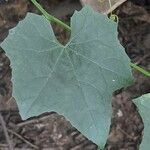Climbers 5-15 m long, stem 2-5 mm diam., glabrescent, scabrous. Probract 3-5 mm long, acute, with (1-)4-8 glands. Tendrils 2-6-branched. Leaves: petiole 2-15 cm long; blade dark green, palmately 3-5(-7)-lobed, c. 1/4 deep or much deeper, lobes various, suborbicular in outline, 5-15 cm diam., glands small. Flowers opening at day-time; bright yellow. Male flowers in peduncled raceme, 5-35 cm long, peduncle 5-12 cm long; bracts (narrowly) ovate, c. 5 mm long, glandular; pedicel 2-10 mm long; receptacle-tube c. 5 mm wide, mostly hairy inside; sepals triangular, acute(-acuminate), 5-10 mm long, with few glands; petals broadly rounded, 20-45 by 15-30 mm; stamens 3 or 5, exerting from receptacle-tube, anthers 3-5 mm diameter. Female flowers: pedicel 10-30 mm long, ovary ellipsoid or cylindrical, 15-30 mm long, finely hairy, smooth or obscurely ribbed. Fruit ripening (light and dark) yellow green, globose, short-to long-ellipsoid or cylindrical, 3-20(-50) cm long, not ribbed, glabrous; pulp fibrous, operculum small, beaked; fruiting pedicel 1-6 cm long. Seeds numerous, dull blackish, elliptic in outline, 7-12 by 4-8 mm, with narrow membranous wing-like border.
long, lanceolate, acuminate, appressed pubescent; petals yellow, oblong cuneate to obovate, 2-3 (-4) cm long, mucronate, the outer surface puberulent, especially toward the base and on the nerves, the inner surface stipitate glandular, also with a few scattered nonglandular hairs, prominently ribbed, the stamens 3, free, the filaments 6-10 mm long, slender, puberulent, ciliate at the base, the anthers flexuous. Pistillate flowers solitary, axillary; peduncles 2-10 cm long; calyx and corolla as in the staminate flowers; ovary fusiform, ca. 1.5 cm long, appressed pubescent, 3-carpellate, the ovules numerous, horizontal, the styles connate, the stigmas 3, bilobate, densely papillate, staminodia 5, ca. 1 mm long, pubescent, the tip glabrous. Fruits green, longitudinally striate with darker markings, cylin-drical or fusiform, 10-30 cm long, ecostate, dehiscent by a conical, long-beaked operculum; seeds gray, mottled with darker markings, ovoid, compressed, 8-12 mm long, 7-10 mm wide, the margin narrowly winged, 2 oblique bumps present above the hilum on each surface, the testa granulate.
Stems climbing to many metres. Tendrils 3–6-branched. Probracts narrow, 3 mm long, acute, glandular. Leaves ovate, cordate at base; lamina 6–18 cm long, 6–20 cm wide, palmately 3–5–lobed; lobes triangular to lanceolate, entire, dentate to sinuate-dentate, acute, acuminate or apiculate; petiole 2–15 cm long. Male flowers in 5–20–flowered racemes 10–35 cm long; peduncle 5–12 cm long; pedicels 2–10 mm long with small glandular bracts; hypanthium 4–8 mm long, pilose inside; calyx-lobes triangular, 8–12 mm long, acute; petals ovate to spathulate, 20–45 mm long; stamens 3 or 5. Female flowers on pedicels 1–3 cm long; ovary cylindrical-ellipsoidal, 20–35 mm long, pilose. Fruit ellipsoidal to cylindrical-ellipsoidal, attenuate at apex, 5–15 cm long, 3–7 cm diam.; pedicel stout, to 6 cm long. Seeds 9–12 mm long, black.
Vines climbing or trailing to 15 m; tendrils 3–6-branched; stems not angled, finely hairy or glabrous. Leaves: petiole 2–15 cm; blade dark green, ovate-cordate, (3–)5-lobed, 6–20(–30) × 6–25 cm, lobes triangular to ovate, margins entire or sinuate to sinuate-toothed or sublobulate-dentate, apex acute-apiculate, surfaces scabrous. Staminate racemes (5–)15–20-flowered, 12–35 cm; peduncles and pedicels erect to spreading. Flowers 5–10 cm diam.; hypanthium 4–8 mm, sepals longer than tube; petals bright yellow, 25–45 mm, apex shallowly obtuse to obtuse-apiculate; stamens (3–)5; filaments 6–8 mm. Pepos cylindric, not angled, (6–)20–50 × (2.5–)6–10 cm. Seeds dull black, not beaked, 10–12 × 6–8 mm, surface smooth, glabrous, margins with wings ca. 1 mm wide. 2n = 26.
Monoecious, tendriled vines; stems 5-to 10-sulcate, pubescent to glabrate. Leaves with the blades suborbicular in outline, 10-25 cm long, as wide or slightly wider than long, apex acuminate to caudate, the base deeply cordate, the margin denticulate, chartaceous, the upper and the lower surfaces scabrous with pustu-lar based trichomes; petioles 4-12 cm long, slender, pubescent to glabrate, stri-ate; tendrils 3-to 5-branched, pubescent to glabrate. Staminate flowers in axil-lary racemes, the rachis 10-35 cm long, appressed pubescent, glabrate toward the base, 10-to 30-flowered in the upper half, the pedicels 1-2 cm long, pubes-cent; calyx campanulate, lobed for %i or more its length, the lobes 10-15 mm
An annual climber with yellow flowers.

